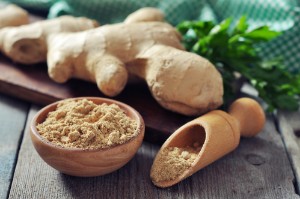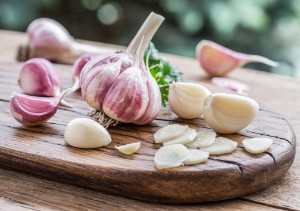Nutrition for strengthening ligaments and tendons – 7 healthy foods according to scientists
 Ligaments and tendons are extremely important elements of the human musculoskeletal system that hold bones together.
Ligaments and tendons are extremely important elements of the human musculoskeletal system that hold bones together.
Under the influence of various causes (malnutrition, injuries and hereditary diseases, severe somatic pathologies on the part of other organs), the functional state of connective tissues is disrupted, which can lead not only to a change in the quality of life, but also disability.
There are many nutrients needed to maintain adequate functioning of the musculoskeletal system and accelerate the regeneration of damaged connective tissue (in tendons and ligaments).
Below are 7 foods that are useful for strengthening ligaments and tendons. It is recommended to include them in the daily diet in the presence of diseases of the musculoskeletal system or a tendency to them, as well as during active physical activity.
1. Dairy products
 Milk is a valuable source of calcium, tryptophan and other amino acids for the human body.
Milk is a valuable source of calcium, tryptophan and other amino acids for the human body.
Calcium provides full-fledged neuromuscular transmission, maintains tone and provides muscle contraction, which has a beneficial effect on the condition of the ligaments.
Tryptophan increases the rate of synthesis of ligamentous and tendon complex tissues, promotes the assimilation of essential amino acids that enter the body with food. Proven that a decrease in the content of tryptophan in food has a negative effect on the work of the musculoskeletal system.
In addition, dairy products Improve immunity .
2. Rich meat broths
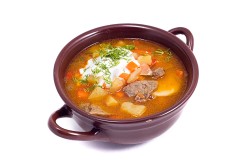 Decoctions from meat products, which contain not only meat, but bones, tendons and skin as raw materials, are rich in hyaluronic acid. Especially valuable are the crests of roosters and chickens, chicken paws.
Decoctions from meat products, which contain not only meat, but bones, tendons and skin as raw materials, are rich in hyaluronic acid. Especially valuable are the crests of roosters and chickens, chicken paws.
Hyaluronic acid is absorbed in the intestine, breaks down into separate protein metabolites, which then flow to ligaments, tendons and joints. They are necessary to repair damaged tissues.
The University of California found that hyaluronic acid helps to increase the content of type III collagen in damaged ligaments, which significantly improves repair and enhances the formation of blood vessels for nutrition and oxygen supply. A decrease in the intensity of inflammatory processes was also noted.
3. Nuts
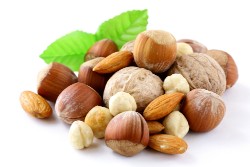 Nuts contain huge amounts of vitamin E.
Nuts contain huge amounts of vitamin E.
One of the experiments on rats showed that vitamin E deficiency in the diet for 5 months leads to spinal deformity (kyphoscoliosis) due to weakness of the ligamentous apparatus.
Peanuts and almonds are the most rich in vitamin E.
4. Bell pepper
 Bell peppers contain significant amounts of vitamin C and collagen.
Bell peppers contain significant amounts of vitamin C and collagen.
According to foreign research, the consumption of several peppers per week leads to an increase in the collagen content in ligaments and tendons, increases the delivery and proper utilization of protein elements.
5. Fatty fish varieties
 Seafood contains a large amount of the valuable amino acid tryptophan. This substance is one of the main building blocks for bone tissue, tendons, ligaments and skin.
Seafood contains a large amount of the valuable amino acid tryptophan. This substance is one of the main building blocks for bone tissue, tendons, ligaments and skin.
The amino acid not only increases the rate of tissue repair, but also contributes to mood normalization (for depressive disorders), gives an attractive aesthetic appearance to the skin.
Scientific experiments demonstrate that tryptophan deficiency can lead to significant lesions. There is a pronounced curvature of the spinal column (due to the loss of functional activity of the ligamentous apparatus). Also, the lack of tryptophan increases the content of calcium, magnesium and sodium in the body, leading to multiple organ disorders.
In addition, fatty fish is one of the 11 Foods Most Beneficial for Joints .
6. Chicken eggs
 Chicken eggs contain a wide range of vitamins (D, C, E, B), macro- and microelements, essential amino acids, which are the building blocks for body cells.
Chicken eggs contain a wide range of vitamins (D, C, E, B), macro- and microelements, essential amino acids, which are the building blocks for body cells.
Eggs contain a significant amount of collagen, which is broken down into valuable amino acids (proline, lysine, glycine) and is used by ligaments, cartilage and muscles.
According to research, with a lack of collagen supplied with food, there is a decrease in bone density, suppression of muscle tone, as well as loss of elasticity of ligaments and tendons.
To increase the absorption of collagen from eggs, you should additionally consume foods rich in vitamin C (bell pepper, citrus fruits, strawberries, pineapple).
7. Red grapes
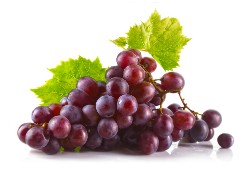 Grapes have a wide range of properties: slows down aging, prevents the formation of atherosclerotic overlays on the walls of large vessels
, inhibits malignant cell proliferation.
Grapes have a wide range of properties: slows down aging, prevents the formation of atherosclerotic overlays on the walls of large vessels
, inhibits malignant cell proliferation.
Grapes, according to scientific research , prevent the development of autoimmune and inflammatory diseases of the musculoskeletal system, prevents tendon fibrosis of those muscle groups that, for various reasons, are unable to work properly.
There was also an improvement in metabolic processes in the connective tissue of ligaments and tendons.
Other products
 Also, according to scientists
, it is recommended to include in the diet substances rich in magnesium, zinc, selenium, vitamins (B, D, F), iodine, iron, copper and calcium. All the described substances are extremely important for the "construction" of connective tissue.
Also, according to scientists
, it is recommended to include in the diet substances rich in magnesium, zinc, selenium, vitamins (B, D, F), iodine, iron, copper and calcium. All the described substances are extremely important for the "construction" of connective tissue.
To make up for the lack of these substances,
- Legumes (beans, peas) are perfect;
- Dark chocolate (an important source of magnesium);
- Hard cheeses.
What to avoid
 There are many foods that negatively affect the condition of ligaments and tendons. The most harmful are:
There are many foods that negatively affect the condition of ligaments and tendons. The most harmful are:
- Sweets. The most dangerous are sugar, cakes, pastries and sweet pastries. They contribute to the deposition of fat cells in muscle tissue, the development of dystrophic changes, which provokes the degradation of connective tissue.
- Fats. Inhibit the absorption of calcium by myocytes and connective tissue cells. As a result, calcium begins to be actively excreted from the bones, causing osteoporosis. It is necessary to abandon animal fat, as well as prolonged frying of food in oil.
- Oatmeal porridge. Due to the presence of phytic acid in the composition, oatmeal causes a violation of calcium absorption, which negatively affects the entire musculoskeletal system.
Conclusion
Thus, even despite the small number of studies conducted, it can be concluded that diet correction has a positive effect on the functional and anatomical integrity of ligaments and tendons, as well as the entire musculoskeletal system as a whole.

